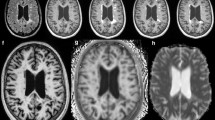Abstract.
The application of image registration and subtraction to detect change in multiple sclerosis (MS) disease burden on serial MR scans benefits from the use of isotropic voxels. An optimised 3D fast fluid-attenuated inversion recovery (FLAIR) sequence with 1.2- and 1.8-mm cubic voxels was compared with a 2D T2 SE sequence using standard 3-mm slices. Three-dimensional fast FLAIR and T2 SE series were obtained in 20 MS patients and 15 controls. Whole brain acquisition times for the 1.2- and 1.8-mm FLAIR were 21 and 10.5 min, respectively, for the interleaved T2 SE 16 min. Brain lesions were marked in consensus by two radiologists and the CNR was calculated in ten lesions. The mean number of lesions detected with the 1.2-mm FLAIR sequence was 115±76, compared with 85±59 for the T2 SE series (p<0.001). The 1.8-mm FLAIR detected only 73±46 lesions. The CNR of the 1.2-mm FLAIR was significantly better than the T2 SE (p<0.01), but not as good as the 1.8-mm FLAIR. In conclusion, isotropic 3D fast FLAIR using 1.2-mm cubic voxels is superior to the 2D T2 SE in the detection of brain lesions in MS patients. The isotropic 1.8-mm FLAIR is faster and has better contrast characteristics but lacks sensitivity.
Similar content being viewed by others
Author information
Authors and Affiliations
Additional information
Electronic Publication
Rights and permissions
About this article
Cite this article
Tan, I., Pouwels, P., van Schijndel, R. et al. Isotropic 3D fast FLAIR imaging of the brain in multiple sclerosis patients: initial experience. Eur Radiol 12, 559–567 (2002). https://doi.org/10.1007/s00330-001-1170-8
Received:
Revised:
Accepted:
Published:
Issue Date:
DOI: https://doi.org/10.1007/s00330-001-1170-8




